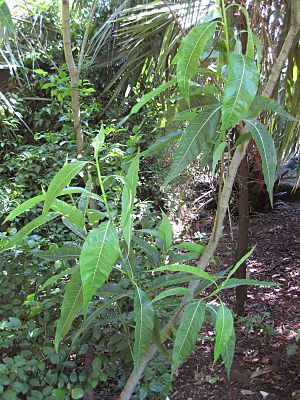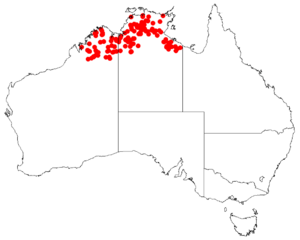Peach-leaf fig facts for kids
Quick facts for kids Peach-leaf fig |
|
|---|---|
 |
|
| Conservation status | |
|
LC (TPWCA)
|
|
| Scientific classification | |
| Genus: |
Ficus
|
| Species: |
coronulata
|
 |
|
| Occurrence data from AVH | |
| Synonyms | |
|
Ficus salicina F.Muell. |
|
Ficus coronulata, also known as the peach-leaf fig, is a type of fig tree. In Australia's Northern Territory, people also call it the river fig or crown fig. It's one of several fig species often called "sandpaper figs" because of their rough leaves. This tree grows naturally in Western Australia and the Northern Territory.
Contents
What is the Peach-Leaf Fig Like?
The peach-leaf fig is a tree that can grow up to 15 meters (about 50 feet) tall. It's a dioecious plant, meaning it has separate male and female trees. Its small branches often hang down.
Leaves and Fruit of the Fig Tree
The leaves are long and narrow, shaped like a spear. They can be quite large, from 5 to 33 centimeters (about 2 to 13 inches) long. The leaves feel a bit rough, like sandpaper. If you look closely, you might see tiny, hard, stony dots on the top surface of the leaves. These are called cystoliths.
The fruit of the peach-leaf fig is round, like a small ball, and can be up to 21 millimeters (about 0.8 inches) wide. These fruits are called syconia. They grow where the leaves meet the stem. When they are ripe, they are green or yellowish-green. The fruit also feels a little rough.
When Does the Peach-Leaf Fig Grow Fruit?
In the Northern Territory, you can find this fig tree flowering in many months, including January, March, May, June, July, September, October, and November. It produces fruit all year round!
This fig is special because of its green or yellowish-green ripe fruit and its narrow, spear-shaped leaves. It is not a strangler fig, which means it doesn't grow around other trees and choke them.
How Scientists Name and Classify the Peach-Leaf Fig
The scientific name Ficus coronulata was first given to this tree in 1862. It was named by a scientist named Friedrich Anton Wilhelm Miquel. He studied a sample of the tree that was found in 1855 in a place called Arnhem Land in Australia.
Where Does the Peach-Leaf Fig Live?
This fig tree grows in many parts of the Northern Territory and Western Australia. It likes to live along rivers and creeks. It has also been found to be a host plant for a type of mistletoe called Amyema benthamii. This means the mistletoe grows on the fig tree.
Aboriginal Names for the Peach-Leaf Fig
Many Aboriginal groups have their own names for the peach-leaf fig:
- The Jaminjung people call it Ngaliwurru and Nungali.
- The Garnimbi and Ngarinyman people call it Jabawi.
- The Mangarrayi and Yangman people call it Garranba.
- The Wagiman people call it mardengdeng and dengdengin.
How People Use the Peach-Leaf Fig
The peach-leaf fig is very useful to many Indigenous Australians in the Northern Territory. They use it for both medicine and food. The Jawoyn people also use parts of the tree to make fire-sticks.
Indigenous people would eat the fruit. They also used to throw the fruit into rivers to attract turtles, which they could then catch for food.
Sometimes, people plant Ficus coronulata in parks and gardens because it can be a beautiful tree.
Images for kids


